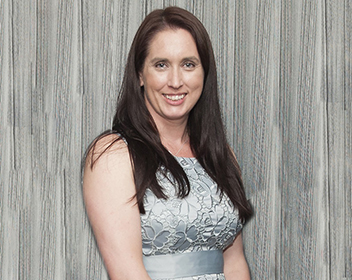Rachel Long CEng MIMMM
Published: 17/07/2019


 Education and qualifications: 2:1 BSc Earth Science (Hons), HND Business Administration
Education and qualifications: 2:1 BSc Earth Science (Hons), HND Business Administration
Which Institution are you a member of? Institute of Materials Minerals and Mining (IOM3), the Geological Society
Current job title: Senior Asset Manager
Company: Network Rail (Scotland)
Where are you based? Glasgow
Please describe your current role
I am currently a Senior Asset Engineer for the Geotechnical, Off-Track and Drainage team in Route Asset Management for the Network Rail’s Scotland route. My role involves looking after the business plan and tracking the cost and volume of work undertaken by our deliverers. I currently help manage a portfolio of over £150m of work across the Geotechnical, Off-Track and Drainage disciplines.
Please provide a brief outline of your career so far
I started my career prior to graduation with a summer placement at Raeburn Drilling, where I learned the basics of ground investigation. Following my graduation from the University of Glasgow in 2006 I joined BAM Ritchies. Working in the Ground Investigation department I was responsible for a wide range of projects on rail, road, private and commercial developments. I used several different techniques to investigate ground conditions, including rotary drilling, trial pitting and sonic boring. I was responsible for compiling reports bringing this information together for the client. I developed my knowledge of ground conditions and the importance of keeping accurate records. My experience in the Ground Investigation Department gave me a good basis for my developing career.
In 2008 I moved into the Geotechnical Department where I undertook ground engineering works including slope stabilisation, piling, anchoring and grouting. I was involved in several projects for roads, tunnels and dams, working for various customers including utility companies, local government and the Ministry of Defence (MOD).
I also worked in the estimating department where I was responsible for pricing and tendering new works, carrying out tender designs for bored piles and ground anchor solutions as well as preparing quality submissions for tender. I was responsible for the promotion and implementation of the Building Information Modelling (BIM) system used. During my time at BAM Ritchies I was also able to work with spray concrete, and drill and blast.
In January 2018 I started a new post at Network Rail. Working for a client is a very different experience from working in contracting and I have gained a new perspective on construction. In my current role I have been encouraged to challenge the way things have been done in the past and help introduce new methods of reporting and monitoring.
Are there any particular challenges or unusual aspects to your role?
The biggest challenge in my current role was getting used to the new systems and people. The last 18 months have been a learning curve that I think I am still working my way through to ensure I perform at my best.
Challenges when I was site based included when I was carrying out the slope stabilisation works on the A83 in Argyle, Scotland, around the stretch of road known as the Rest and Be Thankful, which is the highest point of the A83 (803ft above sea level). The road is prone to landslides and BAM Ritchies were employed after several debris flows from the hillside above the road resulted in road closures and considerable delays. I was site agent for the project which saw the installation of a shallow landslide barrier, specifically designed for the hillside, and an in-channel debris flow VX barrier for the gulley. These were the first debris flow barriers of their kind to be installed in the UK.
Additionally, I spent 18 months carrying out recovery works on the Glendoe Hydro Scheme following major damage to the power tunnel in August 2009. The recovery works included construction of an access tunnel to clear the collapsed material from the main power tunnel. We also constructed a tunnel to bypass the collapsed section of the power tunnel. Both tunnels were constructed using drill and blast techniques. I was part of the bypass tunnel team and responsible for supervising the tunnel works.
Is there a great professional achievement or high-profile accomplishment that you would like to tell us about?
My biggest professional achievement was gaining my Chartered Engineer (CEng) status - this was the culmination of 10 years of hard work on site. During the application process being able to review the projects I had been involved in during the early years of my career reminded me that I have had the opportunity to see things that not many other people would see, such as the inside of a freshly blasted tunnel at Glendoe.
Additionally, in 2016 I received the Technician Medal through the Institute of Materials, Minerals and Mining (IOM3). I did not know I had been nominated for such a prestigious award and I felt proud and honoured to be recognised by my peers and was delighted to receive the award at the Institute’s headquarters in London.
What contributed to your decision to become professionally registered?
Becoming a CEng had always been a career goal. I believe it is important that technical ability is recognised with the right qualifications. Academic learning provides a foundation of knowledge for graduates but practical, on site experience leads to the development of well-rounded and competent engineers. This is what you need to be to pass your assessment to become a CEng.
How has professional registration benefitted your career?
Having CEng status shows I have attained a level of competence that is recognised throughout the industry. It helps me to stand out from the crowd and be recognised by my peers. Chartered status is a common requirement from clients for senior positions on projects, so being a CEng makes me more sought-after.
With an earth science degree working in the construction industry, specifically ground engineering, it has often been difficult in the past to gain recognition. People in my industry usually have a civil engineering background. My degree was not accredited by the Engineering Council, which meant I had to demonstrate the underpinning knowledge and understanding in other ways. The Institute of Materials Minerals and Mining (IOM3) supported me in becoming professionally registered based on my experience and ability.
What advice would you give someone considering professional registration?
I believe that all engineers and technicians should have the opportunity to become professionally registered. Being registered as an Engineering Technician (EngTech), Incorporated Engineer (IEng) or Chartered Engineer (CEng) will not only benefit the individual, but also their employer and the industry.
Even if you think it is too early or you feel you may not be up to standard, speak to your institution, in my case the IOM3, and find out the requirements. They are all very helpful. My advice to anyone considering registration is to apply and demonstrate your competence.
I was asked to submit a technical report on the suitability, design and constructability of flexible barrier systems to control rockfalls and landslides. I found the process straightforward and the interview was far less scary than I had expected it to be. Both interviewers made me feel comfortable and at ease, which allowed me to talk freely about my experience. Overall, I found the process very rewarding. Achieving CEng has made me realise I do have the ability, knowledge and experience to compete with my peers.
How does your employer benefit from your professional registration?
Being a Chartered Engineer demonstrates my competence and knowledge as an engineer, so my employer can have confidence in my ability. It is also beneficial when speaking to designers and suppliers as it shows a level of understanding.
Where do you see yourself in your career in five years’ time or what are your future ambitions?
I would like to develop in my role in the Asset Management team taking new opportunities to develop my knowledge and skills. I will also continue to support and encourage my team to develop their skills and provide assistance to others.
Outside work, is there any activity you enjoy doing in your spare time that relates to engineering?
I have two dogs and when I am not working they take up my time with long walks on an evening and weekend. I have recently rediscovered my love of fitness with early morning circuit classes and Pilates. When not walking the dogs or exercising I also like to cook and find new recipes which is why I need to exercise so much.
Rachel Long CEng MIMMM 
Registered: April 2016





